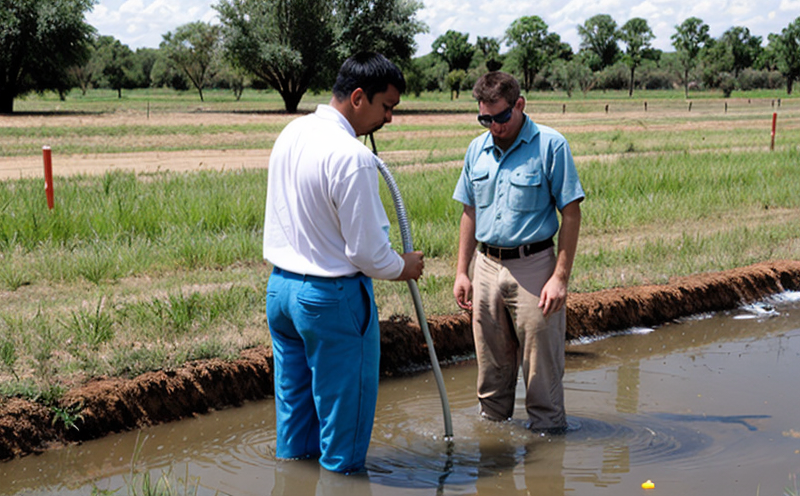EPA 8270 Semi Volatile Organic Compounds SVOC Test in Groundwater
The EPA Method 8270 is a widely recognized protocol for the extraction and analysis of semi-volatile organic compounds (SVOCs) from various environmental matrices, including groundwater. This method employs solvent-based techniques to extract SVOCs from water samples, followed by their analysis using gas chromatography/mass spectrometry (GC/MS).
SVOCs are a class of pollutants that include pesticides, herbicides, polychlorinated biphenyls (PCBs), dioxins, and furans. They pose significant risks to human health and the environment due to their persistence in the ecosystem and bioaccumulation potential. Groundwater is particularly vulnerable to contamination by SVOCs because it serves as a critical source of drinking water for many communities.
The EPA 8270 method aims to ensure that SVOCs are detected at levels below the regulatory limits set forth in the Safe Drinking Water Act (SDWA). Compliance with this method is essential for entities involved in environmental monitoring, waste management, and public health. The protocol's robustness lies in its ability to detect trace amounts of SVOCs even when present in very low concentrations.
During the extraction process, water samples are concentrated using a series of solvent-based techniques that separate the SVOCs from the bulk water. This step is critical for achieving accurate and precise results. The extracted compounds are then analyzed via GC/MS to identify and quantify them based on their unique mass-to-charge ratios.
The method's sensitivity allows it to detect a wide range of SVOCs, making it an indispensable tool in environmental testing. Compliance with EPA 8270 ensures that groundwater is safe for consumption and does not pose risks to public health or the environment. This method also supports regulatory compliance by helping organizations meet stringent water quality standards.
The extraction process involves several critical steps: sample collection, filtration, solvent addition, shaking, centrifugation, and evaporation. Each step must be executed meticulously to ensure accurate results. The choice of solvents and the duration of each step can significantly impact the final outcome. Proper laboratory techniques and quality control measures are essential for maintaining consistency in test results.
After extraction, the samples undergo rigorous analysis using GC/MS. This process involves introducing the extracted compounds into the mass spectrometer, where they ionize and fragment. The resulting ions are detected and quantified based on their mass-to-charge ratios. Identification of SVOCs is achieved by comparing these data points to a library of known compounds.
The EPA 8270 method's versatility allows it to be applied in various scenarios, including groundwater monitoring for compliance with SDWA, site remediation efforts, and research into the environmental fate and transport of SVOCs. Its robustness has made it an industry standard, used by regulatory agencies and private testing laboratories alike.
Compliance with EPA 8270 is crucial for maintaining public health and protecting the environment. By ensuring that groundwater remains free from harmful SVOCs, this method plays a pivotal role in safeguarding drinking water sources and promoting sustainable environmental practices.
Benefits
- Regulatory Compliance: Ensures adherence to stringent EPA standards for SVOCs in groundwater, facilitating compliance with the Safe Drinking Water Act (SDWA).
- Precision and Accuracy: The method's high sensitivity allows for accurate detection of SVOCs even at trace levels, providing reliable data.
- Risk Management: Identifies potential risks associated with groundwater contamination early, enabling proactive mitigation strategies.
- Data Integrity: Maintains consistent and reliable test results across multiple samples, enhancing the credibility of environmental data.
- Confidence in Results: Provides confidence to stakeholders that water sources are safe for human consumption and do not pose risks to public health or the environment.
Why Choose This Test
- EPA Method 8270 is a well-established protocol with a proven track record in SVOC analysis.
- The method's sensitivity and accuracy ensure reliable results even for trace amounts of SVOCs.
- It supports compliance with stringent environmental regulations, enhancing an organization's reputation and trustworthiness.
- Precision and consistency are guaranteed by the method's robust protocols and standardized procedures.
Competitive Advantage and Market Impact
EPA Method 8270 is a cornerstone of environmental testing, providing organizations with a competitive edge in demonstrating their commitment to public health and environmental stewardship. By ensuring compliance with regulatory standards, companies can build trust among stakeholders, including customers, regulators, and the general public.
The method's reliability also enhances an organization's ability to respond effectively to potential risks associated with groundwater contamination. Early detection of SVOCs allows for timely interventions, reducing the likelihood of costly remediation efforts and reputational damage.
Furthermore, compliance with EPA 8270 can contribute to a company's sustainability goals by promoting responsible environmental practices. This alignment with regulatory standards positions organizations as leaders in the industry, fostering long-term success and growth.





